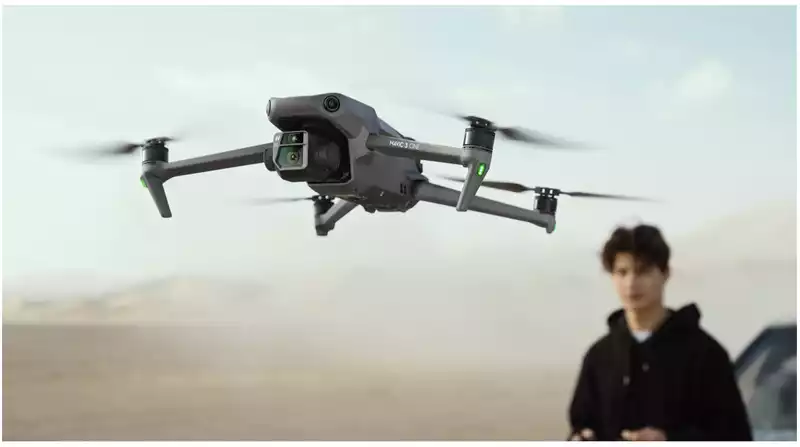After much speculation about the DJI Mavic 3, DJI's newest drone was officially unveiled today (Nov. 4) with two cameras (one with a 4/3 sensor and the other with a 28x zoom lens) and many other features, including a record 46-minute flight time.
Here's everything you need to know about the DJI Mavic 3, including its price, sensors, features, and release date.
The DJI Mavic 3 is available now and will be sold in three configurations:
Mavic 3 Standard Version ($2,199) Includes Mavic 3 drone, intelligent flight battery, RC-N1 remote controller, battery charger, storage cover, and 3 sets of propellers.
Mavic 3 Fly More Combo ($2,999) Mavic 3 drone, 3 intelligent flight batteries, RC-N1 remote controller, battery charger, storage cover, battery charging hub, ND filter set (ND480632), carrying bag, 6 pairs of propellers.
Mavic 3 Cine Premium Combo ($4,999)Mavic 3 Cine drone with built-in 1TB SSD for Apple ProRes 422 HQ video recording, 3 intelligent flight batteries, RC-N1 remote controller, battery charger unit, storage cover, battery charging hub, DJI RC Pro, ND filter set (ND482632), ND filter set (ND64128256512), 10Gbps Lightspeed data cable. [Additional batteries are $209 each.
Starting at $2,199, the price is well above DJI's other Mavic drones. The next most expensive, the Mavic 2 Pro, starts at $1,599. Still, the Mavic 3 is about $1,000 less than DJI's Inspire 2 professional drone. [The DJI Mavic 3 can be pre-ordered at dji.com and Adorama.
For the first time, the DJI Mavic 3 will feature not one but two cameras: the first is a 4/3 CMOS Hasselblad camera and the second is a 28x hybrid zoom camera with 4x digital zoom on the main lens and 7-28x zoom on the tele lens.
The main camera can capture 20MP still images in 12-bit RAW format and 5.1K video at 50fps and 4K at 120fps; the 24mm-equivalent lens has a field of view of 84 degrees and an adjustable aperture from f/2.8 to f/11.
The second zoom lens is equivalent to 162mm and has an aperture of f/4.4, so it should do quite well in somewhat darker conditions.
The Mavic 3 can record H.264 video at a maximum bit rate of 200 Mbps and H.265 video at 140 Mbps.
A special version of the Mavic 3 Cine will have a 1TB SSD built in and will be capable of Apple ProRes 422 HQ encoding at a maximum data rate of 3772 Mbps.
How much of a leap is the Mavic 3 compared to the Mavic 2 Pro? The chart below does not cover all the differences between the two models, but there are some significant upgrades.
For starters, the Mavic 3 is slightly larger than the Mavic 2 Pro, but somehow lighter. Also, while the maximum hover time is only slightly closer, the flight time is much longer with the Mavic 3, 46 minutes vs. 31 minutes.
Because the Mavic 3 has a larger image sensor, it also has a much higher resolution when shooting, 5.1K/50fps versus 4K/30fps. Additionally, the Mavic 3 doubles the resolution when shooting at higher frame rates.
Like the Mavic 2, the Mavic 3 has six fisheye lenses and two wide-angle sensors on all sides, allowing it to not only avoid obstacles, but also to chart a course around them.
Active Track 5.0 should allow the Mavic 3 not only to better track its subjects, but also to fly beside and around moving objects, which should allow for more cinematic shots.
The Mavic 3 also features DJI's new O3+ transmission system, which allows the drone to stream 1080p/60fps video directly to the controller, covering up to 15 km.
With the updated Return to Home feature, the Mavic 3 automatically determines the shortest, safest, and most energy-efficient route to land at the home point.
The Mavic 3 will not work with DJI's FPV goggles at launch, but company representatives say that integration may be possible in the future through firmware updates.
Perhaps the most impressive feature of the Mavic 3, aside from the camera, is the expected flight time: according to DJI, the Mavic 3 can remain in the air for up to 46 minutes, which is 12 minutes longer than the Mavic 2's maximum flight time of 34 minutes.
Of course, battery life is affected by a variety of factors, including ambient temperature, wind conditions, and how the drone is operated, but it is a great leap forward. Hopefully this will spill over to DJI's other drones.
The DJI Mavic 3 seems like a big step forward from the previous generation. Its dual camera system, along with longer flight times and enhanced tracking system, seem to make the Mavic 3 one of the best drones for videographers without the budget or need for a full-sized professional system.
While DJI's sub-$2000 models are sufficient for most casual drone operators, the Mavic 3 may become the new go-to drone for those seeking a portable yet powerful drone. Stay tuned as we hope to get our hands on a Mavic 3 soon.
.









Comments